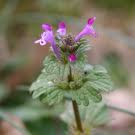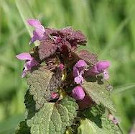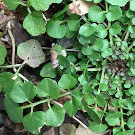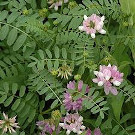11–15 minute read
Check soil moisture before you work
If it is too cold and wet, it is better to delay garden chores. Walking on wet soil or working it to weed or plant causes compaction, which prevents water infiltration and drainage, limits plant root growth, and makes it difficult for plant roots to absorb oxygen and water.
Routine Care
fertilizing
You can fertilize if needed. Avoid stimulating growth before reliable warm weather arrives, because new growth is especially sensitive to cold damage. It is safest to use slow-acting fertilizers because they require warm soil to begin working.
mulching
To stimulate plant growth once cold snaps are past, rake mulch away to allow the soil temperature to increase. When plant growth has begun, return mulch to a depth of about 3 inches, keeping it away from plant crowns.
tidying
- Help beneficial insects by waiting to trim dead foliage and stems until daytime temperatures are consistently above 50°F for at least seven consecutive days. This allows overwintering beneficials time to emerge.
- Remove leaves from your beds to prevent them from smothering new foliage and rotting plant crowns and bark.
- Remove spent flowers from spring-flowering bulbs, but leave the foliage to replenish the bulb for next year. Don’t braid, tie or otherwise damage the leaves, just let them die down naturally. Plant annuals and perennials like hostas among the bulbs to help disguise unsightly foliage.
watering
Water newly-installed or evergreen plants if weather conditions have been dry
- Choose warm days for watering, because plants cannot take up water if the ground is frozen.
- Water retains heat, so watering just before a cold snap can help plant roots survive bitter temperatures. </li>
houseplants
- Start feeding houseplants again.
- Watch for indoor insect pests. Most can be controlled easily with insecticidal soap.
Special tasks
planting & Propagating
Because root repair is slow when the soil is cold, plant, transplant and divide as early in the month as possible so that roots can recover before top growth begins. In addition, roots are not yet bound to the soil. Mulch to prevent heave-thaw and stake tall plants to avoid rocking, which tears roots. Water when the soil is dry. New foliage is easily dessicated before roots recover.
- You can continue to plant perennial groundcovers and some trees and shrubs. Most trees and shrubs would prefer planting late next fall or winter, but slow-growing, fleshy-rooted species like magnolias and camellias are good candidates for spring planting.
- Sow hardy annuals, scattering seeds directly where you want them to grow. The best germinators in cold, moist soil are annual phlox, bachelor’s button (aka cornflower), calendula, horned violet, larkspur, love-in-a-mist, moss rose, and sweet alyssum.
- Divide perennials that bloom in late summer or fall as the tips emerge. Perennials that bloom in spring or early summer are best divided in autumn. If you still want to divide hostas in the spring, wait until the first flush of leaves has hardened.
- Take hardwood cuttings of many landscape plants like crape myrtle, forsythia, holly, hydrangea, juniper, flowering quince, spirea, and weigela.
pruning
| Jan | Feb | Mar | Apr | May | Jun | Jul | Aug | ||||||||||
|---|---|---|---|---|---|---|---|---|---|---|---|---|---|---|---|---|---|
| TREES | |||||||||||||||||
| shade | |||||||||||||||||
| bleeder | small branches | ||||||||||||||||
| fruit | |||||||||||||||||
| SHRUBS | |||||||||||||||||
| summer-blooming | after bloom | ||||||||||||||||
| spring-blooming | after bloom | ||||||||||||||||
| broadleaf EG | dieback | ||||||||||||||||
| needle EG | |||||||||||||||||
| HERBACEOUS | |||||||||||||||||
| grasses | |||||||||||||||||
| flowers | pinch, deadhead | ||||||||||||||||
- Trim ornamental grasses and evergreen perennials like liriope, mondo grass, hellebores and epimediums. Note that sedges resent pruning — just comb out dead foliage with your fingers.
- Renew summer-blooming deciduous shrubs by removing ⅓ of the branches of fast-growing shrubs or ⅕ of the branches of slow-growing shrubs. Prune to open the interior to light and air. Do not prune spring-blooming shrubs until after they bloom or you will remove this year’s flowers.
- Remove diseased, dead or undesired tree branches, water sprouts and any crossing limbs.
problems
disease
Be proactive about fungal disease. The best approach is to purchase genetically resistant cultivars. Otherwise, think of fungicides as vaccines that prevent diseases rather than curing them. Apply fungicide when conditions favor disease development but before symptoms appear.
Minimize dogwood diseases. Keep them watered, maintain soil fertility and clean up leaf litter to reduce disease pressure. When purchasing a flowering dogwood (Cornus florida), seek out disease-resistant cultivars like ‘Cherokee Brave’ (pink bloom, partial resistance), ‘Jean’s Appalachian Snow’ (white bloom, high resistance), or ‘Kay’s Appalachian Mist’ (white bloom, high resistance). Alternatively, plant a Kousa dogwood (complete resistance) or a florida-kousa hybrid from the Rutgers ‘Constellation’ series (moderate resistance).
Monitor azaleas and camellias for leaf galls (white, fleshy growths) and pick them off as they form.
Monitor roses for diseases and insects. If you plan to spray, begin as soon as the first leaves appear.
pests
Beneficial insects share the same plants as insect pests. To protect beneficials, use low-toxicity pesticides when possible, spray only if needed and spray at dusk when pollinators are no longer active. Always read and follow label directions for safe pesticide application.
Click on a pest name in the pest calendar below to learn more.
| Jan | Feb | Mar | Apr | May | Jun | Jul | Aug | Sep | Oct | Nov | Dec |
|---|---|---|---|---|---|---|---|---|---|---|---|
| Emerald ash borer | |||||||||||
| tent caterpillar | |||||||||||
| black vine weevil | |||||||||||
| spider mites | |||||||||||
| scales, slugs | |||||||||||
| aphids, lace bugs | |||||||||||
| bagworm | pick bags | ||||||||||
| boxwood leaf miner | |||||||||||
| ironweed longhorn borer | |||||||||||
| flatid planthopper Japanese beetle CATERPILLARS: genista broom moth silvery checkerspot fall webworm | |||||||||||
| twospotted spider mite kudzu bug | |||||||||||
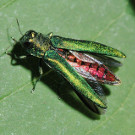 Emerald ash borers have been confirmed in Orange County. They attack all species of native ash as well as our native white fringetree. The top of the crown begins to thin and partially die (sprouting from the main stem of the tree may also occur), followed by death within 2–5 years. While the borers spread a few miles per year by flight, the main route of spread is from contaminated firewood. Interstate movement of EAB-host wood and wood products is prohibited for all of NC. However, movement within our state is not. Please be cautious when purchasing or accepting firewood, wood chips, etc. if you suspect that your trees are infected, please report the location and descriptions of potentially infested trees to 800-206-9333 or newpest@ncagr.gov.
Emerald ash borers have been confirmed in Orange County. They attack all species of native ash as well as our native white fringetree. The top of the crown begins to thin and partially die (sprouting from the main stem of the tree may also occur), followed by death within 2–5 years. While the borers spread a few miles per year by flight, the main route of spread is from contaminated firewood. Interstate movement of EAB-host wood and wood products is prohibited for all of NC. However, movement within our state is not. Please be cautious when purchasing or accepting firewood, wood chips, etc. if you suspect that your trees are infected, please report the location and descriptions of potentially infested trees to 800-206-9333 or newpest@ncagr.gov.
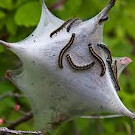 Eastern tent caterpillars often attack young cherries or sourwoods or plants in poor health. Physical removal is an effective strategy — most will be in the tent on a rainy day or at dawn or dusk.
Eastern tent caterpillars often attack young cherries or sourwoods or plants in poor health. Physical removal is an effective strategy — most will be in the tent on a rainy day or at dawn or dusk.
weeds
For common weeds not mentioned below, try this weed gallery. You can check for the toxicity, groundwater risk and persistance of many weed products in Toxicity of Lawn Chemicals.
- Apply preemergent weed control for summer annual weeds by the time dogwoods are in bloom.
- Spray wild onion, wild garlic and winter annual weeds with a broadleaf herbicide, following the label directions. Products work best when the air temperature is
50–80° . - Treat perennial weeds such as wild onion and wild garlic with a broadleaf herbicide when temperatures are above 50°. Be careful to distinguish mock strawberry, an invasive alien, from our native barren strawberry.
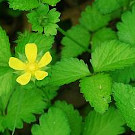 weed mock strawberry
weed mock strawberry wildflower barren strawberry
wildflower barren strawberry - Control invasive vines and unwanted tree saplings.
- For saplings that are too large to pull, cut off close to the ground and clear away debris. Immediately paint or spray the exterior and the cut surface with a 15–25% solution of glyphosate --- waiting more than 5 minutes can prevent absorption. For a larger stump, only the outer two-thirds is live wood and needs treatment.
- English ivy control differs by season. In fall, hand-pull vines and re-visit periodically to remove any residual new growth. In spring, hand-pull or use herbicide.
- Killing or removing weeds before they seed is critical for control. This is especially important for the two new 'superweeds' below. While both are annuals, they are extremely aggressive and produce copious seed, rapidly colonizing your yard if left unattended.



